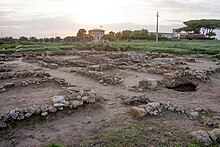Gravisca (Cravsca in Etruscan and Graviscae Latin[1]) was the port of the Etruscan city of Tarquinii, situated 8 km west of the city center.[2][3]
Graviscae | |
 The excavations at Gravisca, conducted by the University of Perugia. | |
| Region | Lazio |
|---|---|
| Type | Port, Settlement |
| History | |
| Periods | Orientalizing period - Roman empire |
| Cultures | Etruscan |
| Site notes | |
| Excavation dates | yes |
| Archaeologists | Mario Torelli |
| Condition | ruined |
| Public access | no |
The Etruscan settlement, occupied ca. sixth to third centuries BC, had four principal occupational phases from ca. 600 to 250 B.C.[4] It was superseded by the establishment of a colonia of Roman citizenship at the site in 181 BC.[5] The port functioned as an emporion and there is ample evidence for merchants and perhaps Greek artisans based at the site.[6] The cults of numerous Greek gods, including Aphrodite, Hera,[7] Demeter, and Apollo, are attested.
The port is mentioned by name in book 10, line 23 of the Aeneid.[8]
References
edit- ^ Mario Torelli et al., “Gravisca,” NSc (1970)
- ^ Denise Demetriou (22 November 2012). Negotiating Identity in the Ancient Mediterranean: The Archaic and Classical Greek Multiethnic Emporia. Cambridge University Press. pp. 83–. ISBN 978-1-107-01944-7.
- ^ Harris, W. "Places: 413157 (Graviscae)". Pleiades. Retrieved July 7, 2019.
- ^ "Casa editrice Edipuglia". Archived from the original on 2008-02-24. Retrieved 2008-05-21. Gravisca. Scavi nel santuario greco
- ^ Liv. 40.29.1.1 http://latin.packhum.org/loc/914/1/1526/45-53
- ^ Benvenuto Frau (1981). Graviscae: il porto antico di Tarquinia e le sue fortificazioni. Gruppo Archeologico Romano.
- ^ Mario Torelli "Il sanctuario di Hera a Gravisca” La Parola del Passato 136 (1971) 44-67.
- ^ The Aeneid. Penguin Books. 2006. p. 299.
